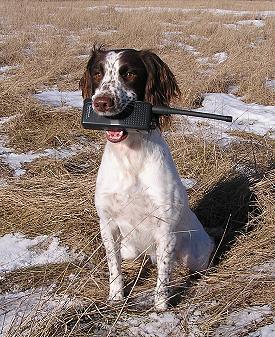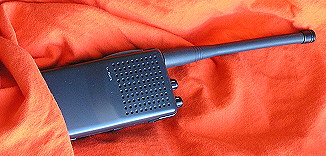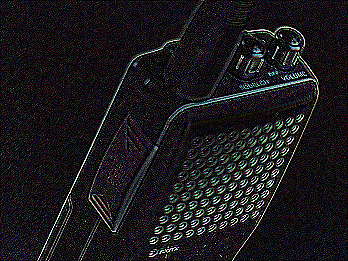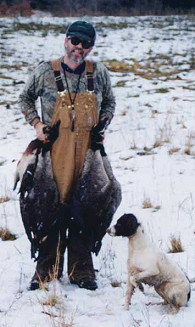 
OK, I'm dating myself with that title - 1972 for those
of you that are too young to remember the Woody Allen
flick - but it brings to mind that there is a lot to
know about these little radios and very little
information to be found. Hopefully we can change that.
Background
In spaniel games, especially in field trials, you may
notice that many people communicate via
walkie-talkies. It is believed that the practice of using "blue dot" walkie-talkies
originated with David Bailey, the co-owner of NFC FC
AFC KB's Sir Coach, sometime around 1990. David
provided pro-handler Dan Langhans with a set of VHF
business-band radios on the frequency of 154.57 mHz
(dubbed by the trade as "blue dot"). Dan would use
these radios to ask his assistant to bring up the next
dog. As people and clubs noticed how well this system
worked, they inquired about getting the same radios.
David helped facilitate these acquisitions - and they
were all "Motorola blue dots".
At that time, the FCC had set apart several VHF
business-band frequencies for itinerant use (no fixed
location), and these were ideal for field trial usage.
To simplify identification (to make sure that you
grabbed a pair of radios that would communicate on the
same frequency - most were single channel), the radios
would often be identified with a colored adhesive dot.
Blue was the color used for the itinerant channel
154.57 mHz, hence the term "blue dot".
It made sense for all communications to be on a common
channel, and because of the initial selection of David
Bailey, blue dot was the channel selected.
Beyond the initial use, bringing the dogs to the line
at the proper time, the use of blue dot radios has
expanded to general coordination of the field trial by
the committee, the announcements of call backs and
the announcements of the current activities.
Generally, the field marshall announces the dogs on
the line, dogs on the ready (next up) and will give a
"play-by-play" without commentary; "Dog number 17 on
his second contact." Because of this, the smooth functioning of a field
trial has come to rely on the use of blue dot radios.
It's hard to imagine how a 40 dog+ field could be run
in a day without the use of radios. But they do have
their downside.
"Its hard to imagine how a 40 dog+ field could be run in a day without the use of radios."
Decorum
Radios, of course, add a certain amount of
artificiality to an already artificial sport. That is,
of course, assuming that you don't conduct pheasant
drives with radios in the field. One glance at the
latest Cabela's catalog will convince you that there
are people who sit around dreaming of the next gadget
that you absolutely need in order to hunt.
On a more practical level, the improper use of radios
at field trials can impede the trial. A review of
"radio decorum" is in order.
1. You may not run a dog with the radio visible on
your body. Because it might be easy for a dog to
mistake the radio for a similar looking
training collar transmitter, having a radio clipped to
your belt or vest might give the handler an unfair
advantage. Therefore, they are prohibited.
I know at least one pro-handler who hands his radio to
someone in the gallery in order to avoid any
controversy. I simply dump mine into my game pouch in
the back of the vest- AFTER turning it off.
2. Radios should be muted in the gallery. Some would
say "turned off" altogether. The purpose here is to
avoid any distraction to the dogs currently under
judgement.
3. Because the blue dot channel is used for official
announcements as well as bringing dogs to the line,
casual conversation should be limited. If extended
conversations are needed, they should be taken to
another channel - green dot is often used for this
purpose. Some committees use a secondary channel for
event coordination such as having another crate of
birds brought to the mid-way point.
4. AKC prohibitions against abusive language and
saying unseemly things about the judges apply to radio
conversations. In fact, you generally will have a
larger audience on blue dot than you will with the
radio turned off. Be careful.
5. When transmissions are not making it from the field
back to the parking area, and you are between the two,
you might assist by relaying important messages. Ask
the marshall if that would be appropriate.
Alternatives
What about the GMRS or FRS radios (talk-abouts)
commonly found at shopping clubs or Radio Shacks? They
cannot communicate with blue dot radios, so they might
not serve the same purpose in the same manner. They
could be used for handler/go-fer communication, but
the information, such as the current "play-by-play"
and call backs, would not be available. The embedded
user-base of blue dot radios makes a transition to
these other services impractical. Given the terrain
and distances encountered, the blue dots likely
provide better service that these "talk-abouts"
anyhow. The big attraction to the GMRS/FRS radios is
that they are marketed to a larger population, and
that scale of production makes these radios more
cost-effective than professional business band radios.
GMRS (General Mobile Radio Service) radios require a
license, and operate on UHF frequencies, which are
higher frequencies than those used by the VHF blue
dots. These higher frequencies may not work as well in
hilly terrain, but do seem to work better in urban
areas. These radios are often used as a low-cost
alternative to business band radios by contractors on
job sites. GMRS handheld radios typically operate with
powers between two and five watts - but the trade off with
higher power levels is less battery operational time
(or more weight).
In 2004, some clubs in the Mid-East experimented with GMRS radios. If field trial clubs switch to these radios, it will be necessary for handlers to have both types of radios available for trials unless a global change is mandated.
I have not heard any feedback regarding these experiments, however my professional opinion is that the GMRS UHF radios will not work as well as the traditional blue dot radios. The most common problem with blue dot radios is battery failure.
When the batteries get weak, the transmissions become fuzzy and range is reduced. Many of the blue dot radios were purchased years ago, and common ni-cad batteries have a finite life. Simply replacing the batteries would revive a lot of ailing radios.
FRS (Family Radio Service) radios do not require a
license, operate at low power, and are generally
suitable for things like keeping the family together
at a theme park or for motor caravans. I have used FRS
radios while deer hunting and the practical range
seems to be limited to a quarter-mile.
The blue dot radios were originally part of the FCC's
BRS (Business Radio Service a.k.a. "business band")
and a license was required. Certain BRS frequencies
were deregulated in November 2002 with the creation of
the MURS (Multiple Use Radio Service). The frequencies
that were involved were "itinerant" (dot) frequencies
including the two 154 mHz frequencies blue dot
(154.57) and green dot (154.60).
Under the new rules, a license is not required,
however, the power limit has been reduced to two watts
from the previous five watts. There were few five watts
units in service as these had reduced battery life
with the higher power although the range somewhat
better. If you hold a BRS license that specifies
operation on 154.57 mHz, you may continue using the five
watt units as long as the FCC continues to renew your
license.
The transition to the MURS service has not been well
publicized and some radio dealers may insist that you
have a license in order to sell you - or reprogram - a
radio. The reference in the Federal Regulatory Code
which authorizes the unlicensed MURS is 47 CFR
95.1301.
The Radios
It seems like the MURS service, featuring radios with
good range while requiring no license, would be a
popular service. Currently, we seem to be stuck at
the transition between licensed (BRS) service and the
new MURS service. As a result, radios may seem
somewhat more expensive than before and harder to locate.
The marketplace seems to be responding to the new service and at least three credible models are now available.
"For the radio neophyte, I would suggest that you not
purchase a radio unless the seller is willing to set
it up on blue dot or blue dot/green dot with no
privacy codes."
Because the radios commonly used for this service are
normally associated with business band use, they are
built to a higher level of quality than many other
services. Consequently, they cost more. However, the
return in durability is advantageous.
Motorola, a high-grade manufacturer of professional
radios, has historically been one of the most popular brands in field
trial usage. Perhaps this dates back to David Bailey's
original selection. Motorola radios are also fairly
easy to locate. The family of Motorola radios that is
most often seen at trials is the discontinued Motorola Spirit. The
radio was even available in blaze orange!
The Motorola Spirit series has been discontinued. Perhaps
the best choice among current Motorola units is the Radius
CP-150-V04 four channel unit, which can be obtained on
blue dot - plus green dot and two others - for about $280 from your Motorola dealer.
This is a high-quality unit and should give years of
trouble free service. The accessories are pricey. The less expensive XTN series XV2100 is a single channel two watt unit (the XV1100 is a one-watt unit) with a different marketing scheme.
Used Motorola Radius CT-100's may also be a good option.
Bringing up a close second in usage are the now discontinued Radio Shack
radios. At one time, Radio Shack even marketed and co-branded the one watt Motorola Spirit unit.
I might mention that while one watt units generally have better battery life, the trade off is reduced range.
One watt units are not recommended for marshalling use. Handlers who seldom transmit may find the one
watt unit acceptable... that is, unless thay are late to the line and need to alert the marshall.
There are many other manufacturers - mostly Japanese -
including Legacy (Maxon), Icom and Kenwood. Most of
these are offered as lower cost alternatives to pro-grade units
such as the Motorola. You can find these radios
at your local business two way radio shop; there is one
in most communities of significant size as these are
the same shops that service police and fire
departments. In fact, you might ask a volunteer fireman
where he obtained his personal walkie-talkie, if he
has one.
As a rule, I suggest two watt, two-channel units whenever possible. Multi-channel units with keypads
are far too complicated to use at a field trial and the expense cannot be justified. Here are some suggestions, and ball
park prices for some of the current models on the market:
Legacy (Maxon) also makes a one watt model, the PL1145, for $100 - which might be an inexpensive
alternative for those not needing to transmit. With the two watt Legacy unit, be very careful comparing prices as some
dealers do not include the charger and there are two battery and charger options. One significant dealer of Legacy is
phasing out the product line because of reliability problems.
The Kenwood unit appears to be the best value on the market today. Kenwood has a good name among
radio amateurs (hams) and has been on the US market for at least 30 years.
A FroogleTM search
reveals that the Kenwood radio can be bought for little more than the Legacy PL2215P. However, it comes standard with a
high capacity 1500mAh Ni-Mh battery and a rapid three hour charger. The Legacy typically is supplied with a 750mAh Ni-Cad
battery and an overnight charger and it would actually be more expensive if configured as the Kenwood.
Battery type, size and replacement price are important considerations. Ni-MH batteries do not have
a "memory" like Ni-Cads, so they do not need to be fully discharged to obtain best performance. Ni-Cads rapidly loose
capacity if re-charged before they are fully dis-charged. The Ni-MH batteries are a significant improvement in battery
technology and I predict that Ni-Cads will be hard to find in just a few years. You also should look at the prices for
accessories such as chargers - even six slot chargers for your club. Some inexpensive models may have accessories price
higher than an upscale model.
Alternate Sources
Obviously there are internet dealers that might offer
some good bargains. You can Google (or Froogle) the manufacturer and model number and get some good leads as shown above.
E-bay is an excellent place to buy used radios, IF you
have the knowledge to determine whether the radio will
actually work on blue dot and if you are willing to
tackle reprogramming the unit if it is not set up for
blue dot. Being as I have such qualifications, I was
able to buy a Spirit and a Radio Shack unit for about
$30 each. Caution: The Spirit radio is also available
in a UHF version; it will not work on blue dot.
Used Radio Shack BTX-127 (two watt) and BTX-128 (one watt)
units are also popular on E-bay. Let me emphasize again that the Radio Shack/Motorola Spirit BTX-128 unit, #19-1217, has a transmit
power of only one watt. The BTX-127, with twice the power, also has a better reciever than the BTX-128.
The usual pitfalls of buying on E-bay apply here too.
One of the units that I purchased was new, less charger,
box and manual... and had the serial number plate
removed. When I contacted the only dealer within 50
miles of the seller, it was discovered that the seller
also worked for the dealer. Fortunately for me, the
dealer did not press charges (family member?) and
therefore I did not have to return the radio at my
loss.
When buying used, you may have to deal with missing accessories (i.e.
charger) and/or worn out rechargeable batteries. Most used units will feature Ni-Cad batteries near the end of their life cycle.
Replacement of these items may bring the cost up to a
new unit.
Programming
For the radio neophyte, I would suggest that you not
purchase a radio unless the seller is willing to set
it up on blue dot, or blue dot/green dot with no
privacy codes. I have programmed several units and
each is different. Units must be programmed to specific frequencies and
privacy codes. A privacy code - also know as "tone
squelch" or "CTCSS" - allows the receiver to remain
quiet unless the transmission has that code
(sub-audible tone) embedded within. Since the standard
for spaniel games appears to be "no code", you must
have your unit set up to receive all transmissions.
Not all units even offer this option.
The simplest units, such as the Radio Shack BTX-127,
use "dip switches" - dip meaning "dual inline pins"
which refers to how it is soldered on the circuit
board. With the 127 you simply open the battery cover
and set the switches (there are six) to
"off-off-off-off-on-off" from left to right for blue
dot operation. Simple. "Off" is the down position.
Radio Shack, by the way, will not supply this
information to you but will insist the unit take a
trip to the regional repair center. Most of their clerks
do not have access to these codes.
"Speak at a normal volume - speaking louder does not
make your signal stronger and will, in fact, cause the
signal to become distorted."
To set the CTCSS code on the BTX-127, set all switches
to OFF (down) then turn the unit on while holding the
PTT button in. The radio will beep when you turn it
on - then release the button and you will hear a
longer beep. Finally, turn the unit off and return the
switches to "off-off-off-off-on-off". These
instuctions may work on the 128 as well.
The Motorola Spirit, Kenwood and many other units, use a
complicated procedure whereby you turn the unit on
while holding several buttons down at the same time.
You blindly scroll down the programming procedure by
pushing certain buttons and listening to a synthesized
voice or, in some cases, a series of beeps. This is not
for the faint of heart although I was able to
successfully program a Midland unit between series at
a trial.
Here is the procedure for the Kenwood TK-2200:
It would be easier to ask your dealer to program the unit thusly:
Channel 1- Blue Dot (Table 3) 154.57, QT-none, DQT-none If you buy your radio from 2wayradioplus.com, Chet has agreed to
program them according to these instructions at no extra charge. Tell
him you want it programmed for "Spaniel Field Trials".
Here is the procedure for the Motorola Spirit:
The most common problem with blue dot radios is that
privacy (tone squelch) is enabled when it should not
be. A Google-search for the specific model number and
the word "programming" may enable you to gain
information on your specific unit. There are a lot of
hobbyists that enjoy "hacking" their way in to
proprietary programming information and posting it on
the web.
The Legacy units require a computer software program ($35) and a cable to program the units.
I would advise not buying these units unless the dealer will program it to blue and green dot for you. Likewise,
for the Icom unit. The Kenwood unit uses a procedure similar to the Motorola procedure above... but again, it is
best to ask the dealer to program the unit.
Other Considerations
Like so many other gadgets, these walkie-talkies
typically use Ni-Cad rechargeable batteries. Ni-Cads
work best and last longest when you discharge them
fully between charges. After a field trial weekend, I
turn my units on and leave them on for a day or so
before re-charging. Ni-Cad performance suffers in the
cold so keep the unit inside your coat on arctic days,
if possible.
Those who might be concerned about the health effects
of a walkie-talkie (radio frequency radiation) would
do well to read the FCC publication
OET56.
According to this publication, "Because of the
relatively low power levels used (usually no more than
a few watts) and, especially, because of the
intermittancy of transmissions (low duty factor) the
(VHF 2-WAY HANDHELD) radios would normally not be
considered to cause hazardous exposure to users."
Some have suggested that you angle the antenna away
from your face. This will actually improve your range,
so its a good idea, anyway.
Discover where the microphone on your unit is located
and speak into it. On the BTX-127, it is a single hole
in the lower right-hand corner of the "speaker
grille". On the Spirit, it is a series of holes on the
lower left-hand side of the grille. You can check this
out using a second radio to monitor; it makes a huge
difference. Speak at a normal volume - speaking louder does not
make your signal stronger and will, in fact, cause the
signal to become distorted.
Because radios break at the most inopportune times, a
back-up radio might be appropriate for those with
multiple dogs. On the other hand, you may find that
doing it with no radio at all is a delightful
experience. It's amazing how things that once were
luxuries have become essential, but such is life in
these modern days.
|
|
|
| Bookstore | The Bookshelf | Advertise on SJ | Classifieds | Resources | NEW! Events | Letters | Archives | Spaniel Journal | |



